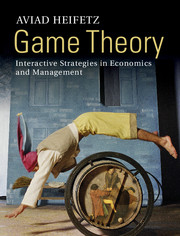Book contents
- Frontmatter
- Contents
- Foreword
- Part I Strategic interactions as games
- Part II Basic solution concepts for strategic form games
- Part III Prominent classes of strategic form games
- Part IV Uncertainty and mixed strategies
- 10 Choice under uncertainty and risk dominance
- 11 Mixed strategies
- 12 Security strategies, strictly competitive games and the minimax theorem
- 13 Mixed strategies in general games
- Part V Advanced topics in strategic form games
- Part VI Dynamic games
- Part VII Repeated games
- Index
- References
13 - Mixed strategies in general games
from Part IV - Uncertainty and mixed strategies
Published online by Cambridge University Press: 05 August 2012
- Frontmatter
- Contents
- Foreword
- Part I Strategic interactions as games
- Part II Basic solution concepts for strategic form games
- Part III Prominent classes of strategic form games
- Part IV Uncertainty and mixed strategies
- 10 Choice under uncertainty and risk dominance
- 11 Mixed strategies
- 12 Security strategies, strictly competitive games and the minimax theorem
- 13 Mixed strategies in general games
- Part V Advanced topics in strategic form games
- Part VI Dynamic games
- Part VII Repeated games
- Index
- References
Summary
In Chapter 11, we defined mixed strategies in games in which every player has two pure strategies. In all the examples cited in Chapter 11, only two players took part in the game.
We will begin this chapter with an example of a game with many players in which there is a Nash equilibrium in mixed strategies. In the game in this example, every player has two strategies. In the second part of this chapter, we will extend the definition of mixed strategies to games in which every player has more than two pure strategies, and explore examples of such games.
The Volunteer’s Dilemma
Consider a group of honest people who witness the perpetration of a crime. Each of these people may prefer that one of the other people in the group come to the aid of the victim or call the police, because volunteering to do so is bothersome and might put the volunteer at risk. What are the Nash equilibria in this sort of social situation, and what are their properties? How do they depend on the number of witnesses?
This question was analyzed by Diekmann (1985). Assume that each of the witnesses, i = 1, . . ., n, has zero utility if nobody volunteers. If at least one of them volunteers to act on behalf of the victim, those who did not volunteer have a positive utility V, expressing their satisfaction with the assistance rendered to the victim. Each of the volunteers has a utility V – C. The term C expresses the effort or the risk experienced by the volunteer. We will assume that V – C > 0, i.e. that a unique witness to the crime would prefer to volunteer rather than to stand aside.
- Type
- Chapter
- Information
- Game TheoryInteractive Strategies in Economics and Management, pp. 211 - 234Publisher: Cambridge University PressPrint publication year: 2012

